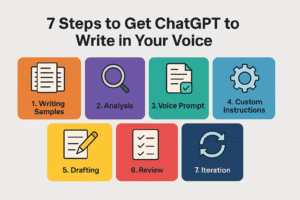7 Steps to Make ChatGPT Sound Like You
Boost Your Internet Profit Success

How to Get ChatGPT to Write in Your Voice: 7 Steps to Internet Profit Success
You ever read something generated by ChatGPT and think: “Cool, but that doesn’t sound like me”? Good news: you can fix that. If you want content that feels authentic, connects with your audience, and helps with your Internet Profit Success, this is the guide. Even if you’ve just opened your AI tool for the first time, I’ve got 7 steps to help you turn ChatGPT into your own writing sidekick.

Step 1: Gather Your Voice Samples
First things first. Collect two or three pieces you’ve written that really speak you. These could be blog posts, past newsletters, personal social media captions—anything where you feel like you nailed your tone. Aim for at least ~200 words each. Why so many? Because ChatGPT needs enough material to see your rhythm, your vocabulary, your sentence length, your sense of humor.
When picking samples, choose ones that are different settings: maybe one formal-ish email, one casual post, one more story‑driven. That variety helps ChatGPT blend what makes you you. The result? Better alignment, more authentic feel when it writes content under your voice.
Step 2: Ask ChatGPT to Analyze Your Voice
Once you’ve got your writing samples, feed them into ChatGPT and say something like:
“Hey ChatGPT, here are some of my writings. Please analyze tone, vocabulary, sentence structure, humour style, recurring phrases—everything that makes my voice distinct.”
Let it break down things like:
Are your sentences usually short or long?
Do you use contractions (“I’m”, “you’ll” etc.) or more formal full forms (“I am”, “you will”)?
What kind of imagery or metaphors do you use?
Do you drop humour? Sarcasm? Anecdotes?
How much punctuation flourish—ellipses, exclamation points, rhetorical questions?
Then look through the style guide output. If something feels off (“ChatGPT says I always use big words”—but you know you don’t), tweak: you might have to give examples of what you don’t want. This helps the tool get closer to your natural voice.
Step 3: Create a Reusable Voice Prompt (Your Style Template)
Now that you know your voice’s ingredients, build a reusable “voice prompt.” This is like a little template you’ll use every time so your style is baked in from the start. Something like:
“Write in my voice: casual, friendly, two‑ to three‑sentence paragraphs, sprinkle in humour, use short stories or analogies, avoid jargon unless necessary.”
You can even include example phrases you often use (“here’s the thing,” “let me tell you,” etc.). Save this voice prompt somewhere easy to grab (Google Docs, note app, whatever). Every time you ask ChatGPT to write something, paste it in or load it via custom instructions.
Step 4: Use ChatGPT’s Custom Instructions or Always Include Your Voice Prompt

If your version of ChatGPT supports custom instructions (or a similar “profile / settings” feature), load your voice template there. That way, you don’t need to repeat it manually all the time. If not, include your voice prompt at the start of every new session or new piece of content.
Tell it:
The tone (casual / funny / conversational / etc.)
The structure you like (short paragraphs, mix of sentence lengths)
Words/phrases you like to use (and ones you avoid)
Audience: this helps shape voice‑choices. If you’re talking to beginners, you’ll likely avoid jargon; if speaking to peers, maybe you go deeper.
By doing this, you set up a consistent baseline for everything, which is essential for building authority, reader trust, and ultimately driving toward Internet Profit Success.
Step 5: Draft with Built‑In Voice + Real Topics
Now you’re ready to tell ChatGPT: “Draft [type of content] about [topic] using my voice template.” For example:
“Write a 300‑word blog introduction about how to pick email tools, using my voice: friendly, short sentences, humour, stories.”

At this stage, let ChatGPT do the heavy lifting. Focus on content value: tips, insights, examples. Don’t worry if it’s not perfect. The voice is already baked in via your prompt. If ChatGPT misses a beat (uses a phrase you don’t like, slips into overly formal language, etc.), flag it or rewrite that section.
Also: while drafting, think about searches people might be doing. Use your main keyword “get ChatGPT to write in your voice” a few times (heading, intro, body). Also pepper related terms (ChatGPT voice prompts, personalize ChatGPT writing style) naturally. SEO + authenticity = combo win.
Step 6: Review & Personalise (Add the “You” Touch)
Here’s where you shine: read through the draft, infuse extra bits that make it unmistakably you. Add:
A small anecdote (“That one time I tried…” etc.)
One of your favourite phrases or jokes
A turn of phrase only you would use
If certain lines feel “too generic ChatGPT,” you can ask: “Rewrite this sentence/paragraph to sound more casual / sassy / like me.” You might also remove or replace words ChatGPT overuses or ones that feel off‑brand.
Don’t forget to check readability. Short paragraphs, simple words (unless big words are your thing), varied sentence lengths. These keep people reading, keep them interested. And interest leads toward trust. Trust helps with clicks, shares, maybe sales—or whichever path in your Internet Profit Success journey.
Step 7: Iterate and Refine Over Time
Your voice may shift and evolve. That’s totally normal. So keep collecting new stuff you write, feed it back into ChatGPT voice analyses. Update your voice template with new favourite phrases, tone tweaks, or structural changes.
Also, compare what content performs well (in terms of engagement, shares, opens, whatever metric you use) and what doesn’t. If certain style choices correlate with higher engagement, emphasise them. If some phrases or structures seem to flop or feel awkward, drop them.
Over time, this loop (write → review → refine) builds stronger content voice. And consistent voice often leads to better recognition, more loyalty, more conversions, etc.—that’s what feeds into Internet Profit Success.
Bonus: Common Pitfalls & How to Avoid Them
Make sure you avoid making your content too repetitive. If every paragraph starts with “So,” or “And,” readers will get tired. Mix up sentence beginnings, vary rhythm.
Avoid letting ChatGPT sneak in generic filler words or phrases you don’t normally use (“utilize,” “implement,” etc.) unless that’s part of your voice. Sometimes AI drifts formal or overly “SEO‑optimized” in a way that erases personality.
Don’t forget to balance authenticity with clarity. Your voice is crucial; but if something you write is confusing, heavy, or too quirky, clarity suffers. Readers may bounce. So defuse complexity with examples, simple analogies, humour.
Also, watch keyword stuffing. Using “get ChatGPT to write in your voice” too often, or shoehorning “Internet Profit Success” everywhere, can make your content feel forced. Use keywords naturally.
How to Use Your Voice in Different Content Types
Blog Posts: Allow more storytelling, longer form. Your voice here shows up in how you frame ideas, which examples you pick, how you joke, how you lead with your perspective.
Emails / Newsletters: More personal. Might use “you” a lot, ask rhetorical questions, share little stories or lessons. Your voice here builds connection.
Social Media Posts: Punchy, vibrant. You can afford more slang, humour, quicker pivots. Loosen up more than in blog posts, if your audience expects that.
Sales Pages / Landing Pages: Still authentic, but mix in persuasion. Retain your tone, but ensure benefits are clear and the flow is logical. You might need slightly more structure, but don’t lose your personality.
Video Scripts / Podcasts: Voice here includes pacing, pauses, jokes. When writing, imagine you speaking to a friend. That mental modelling helps.
Putting It All Together: Sample Prompt Workflow
Here’s a mock workflow showing how you might actually do this, to get to Internet Profit Success.
Collect two pieces: your most-liked newsletter + a casual blog post
Ask ChatGPT to analyze your voice based on those
Build your voice template (“friendly, informal, jokes, short paragraphs”)
Insert that template into custom instructions or always start prompts with it
Ask ChatGPT: “Write 800‑word article on [topic] using my voice + include main keyword get ChatGPT to write in your voice”
Review the draft, add your stories, swap words you don’t like, check tone
Update your voice template with any new favourite phrases, then use for next piece
By repeating this, you build a content style that feels real, resonates with your audience, and works better because it isn’t just “AI output” — it’s you amplified.
Why Finding Your Voice Matters for Internet Profit Success

When you get ChatGPT or any AI tool writing in your voice, people feel like they know you. That builds trust. Trust leads to more shares, more engagement. More engagement helps you rank, helps your brand spread. That in turn means more opportunity to monetize, to sell, to grow—whatever your path.
Also, authenticity helps you stand out. Tons of content out there sounds generic. If you consistently show up you, people remember. They come back. They recommend. That’s the engine behind many successful online creators, businesses, and brands.
Plus, when people believe in you, they’ll invest in your ideas, your services, products. Your voice becomes part of what they buy.
Conclusion
If you want to get ChatGPT to write in your voice, start with what’s already uniquely you. Your past writing. Let ChatGPT analyze it. Build a voice template. Use it every time. Then review, tweak, iterate.
Do that, and not only will your content sound authentic—it’ll help you more credibly reach toward Internet Profit Success. Authentic content isn’t just nice to have, it’s a key part of standing out.
If you want more help watch these FIVE FREE VIDEOS.
